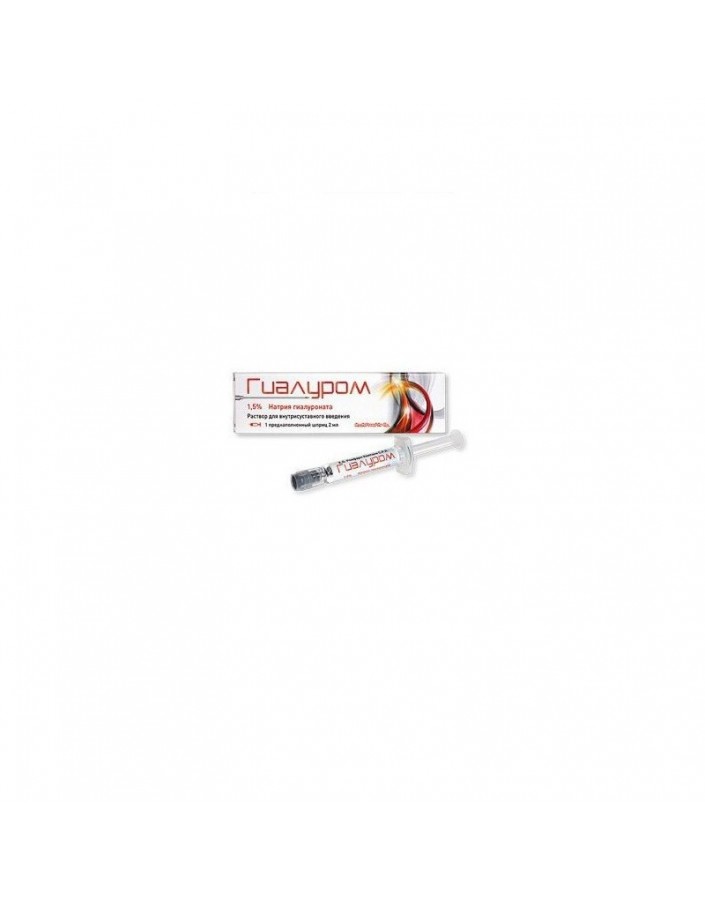



HYALUR SYRINGE SOLUTION INTRAARTICULAR 1.5% 2 ML - 1 pc

Security policy (edit with Customer reassurance module)

Delivery policy (edit with Customer reassurance module)

Return policy (edit with Customer reassurance module)
Solution for intraarticular injection
1 syringe contains:
Active substances: sodium hyaluronate, sodium chloride, water for injection.
Packaging
Syringe 2 ml.
Solution for intra-articular administration of the drug with hyalur 1.5% solution of sodium hyaluronate in disposable syringes of 2 ml is a sterile, viscoelastic solution of sodium hyaluronate. Sodium hyaluronate is obtained as a result of fermentation. Sodium hyaluronate Hyalur solution is a polysaccharide identical to a human, consisting of repeating disaccharide units of N-acetylglycosamine and sodium glucuronate, with a molecular weight exceeding 2,400,000 Da. Sodium hyaluronate is present everywhere in the human body and is present in high concentrations in tissues such as the vitreous, synovial fluid, umbilical cord and dermis. In synovial fluid, sodium hyaluronate acts as a lubricant and shock absorber, which promotes normal movement without pain. In case of a disease such as arthritis, the viscoelasticity of synovial fluid decreases, so it significantly increases the mechanical load on the joint and increases the destruction of the articular cartilage, manifested by limitation and pain when moving in the joints. Lubricating and absorbing effect of the drug Hyalur soothe pain and improve joint mobility during intra-articular use. These effects last more than 6 months after a single course of treatment.
Hyalur, indications for use
Hyalur solution is used as a viscoelastic supplement to replace synovial fluid for pain caused by degenerative diseases of the synovial joints, such as osteoarthritis or osteoarthritis. By its action, the drug Hyalur serves as a lubricant and mechanical support for the sore joint.
Hyalur solution is injected into the joints of a person:
Contraindications drug Hyalur
Dosage and administration of the drug Hyalur
Hyalur injections are made by specialist doctors. Hyalur solution is intended only for intra-articular use. Do not use intravenously. Sodium hyaluronate is administered at room temperature. The volume injected depends on the size of the joint, but does not exceed 2 ml per knee and other large joints, or 1 ml for small joints. The physician is responsible for determining the applicable volume and must ensure that the joint is not overloaded. Hyalur solution is injected into the cavity of the joint once a week for 3 weeks in a row. Perhaps the simultaneous treatment of multiple joints. Repeated treatment cycle can not be carried out earlier than after 6 months for the same joint. Before using the drug Hyalur, accumulation of fluid in the joint should be removed by sucking a syringe. Hyalur solution is produced in the form of a pre-filled syringe, the contents of which do not need to be diluted. The drug is sterile and should be used immediately after opening the package. The drug is intended for single use only. Hyalur should be gently injected into the joint cavity, carefully observing the injection schedule. Introduction is an aseptic procedure, so take proper precautions. The finished syringe is removed from the sterile case, the cap is removed, and then a sterile needle is put on, which is fixed with a slight twist. Before introduction it is necessary to remove air from the syringe.
Sodium hyaluronate has excellent tolerability. Local secondary phenomena may appear, such as pain, sensation of heat, redness and swelling, can be observed on the joint in which the drug is injected (applying ice to the joint for five to ten minutes will remove all such phenomena).Allergic reactions are extremely rare. With intra-articular administration, there are minimal risks associated with infection and bleeding.